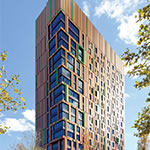Gustav Klimt’s 1909 mural “The Tree of Life” depicts the oft-used, eponymous symbol of the network between heaven, earth, and the underworld with swirling branches and deep roots meant to evoke interconnectedness while symbolizing life’s perpetuity and complexity. At the Boston-area Massachusetts College of Art and Design, that painting serves as the inspiration for its new residence hall, affectionately referred to as “The Tree House.”

MassArt’s new student residence, a finalist for Best Tall Building of the Americas by the Council on Tall Buildings and Urban Habitats, houses 500 students on 21 floors.
“The Gustav Klimt painting helped us both from an aesthetic point of view and a remembrance to keep things simple,” says B.K. Boley, design principal and director of sustainable design for ADD Inc., the architecture firm in charge of the project. The 21-story, 260-foot tall building is made to look like a tree through the use of 5,500 colored panels, which alternate between various shades of brown and a vivid green.
Before the building was designed, students participated in a series of charettes to discuss the functions of each space and the sustainable aspects of its design. “They wanted a building that had more of a simple, sustainable design gesture and not a high-tech [one],” Boley says. “They didn’t want renewable doodads all over the building.” Ideas like solar panels and wind turbines were bypassed in favor of a more organic feel. These ground-laying discussions would lead to the concept of a tree house, the structure’s passive-solar approach, and a heavy concentration on its health and durability. Among the simple solutions: a tightly insulated skin that uses spray-foam insulation inside studs along with exterior rigid insulation.
The building is actually shared by three institutions: MassArt, the Massachusetts College of Pharmacy and Health Sciences, and the Wentworth Institute of Technology. In order to make the project economically feasible and sustainable, these communities had to work together closely. “From the beginning, the project had this very simple vision that was built from consensus,” Boley says.
Although the project’s origins stem from the fact that less than thirty percent of MassArt students were living on campus, the building ended up meeting a number of needs, including connecting the institution to the greater Boston academic community. Before its construction, MassArt had no strong representation on the Avenue of the Arts, which holds all of Boston’s major art institutions. “They were looking for a vision that not only identified MassArt as a major producer of arts,” Boley says, “but also as a symbol of growth and change—not only for MassArt, but also for the city’s architecture and design.”
Next project: The University of Washington’s West Campus


